COLUMNS
360º Architecture
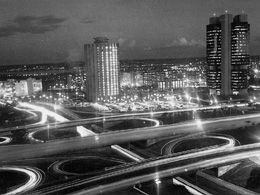
30 April, 2010
Brasília, ‘capital of the highways and skyways’
Few days ago, on 21 April, Brasília celebrated its 50th anniversary.
Judging by the very few articles in daily newspapers and reports in other news media, the event passed virtually unnoticed. It was literally overshadowed by the volcanic ash cloud from Iceland that caused the almost week-long closure of large parts of European airspace. Rather ironically, Brasília, the only city built in the twentieth century that has acquired the status of World Heritage Site (1987), resembles an aircraft seen from above.(1) Commercial aviation had begun in Brazil in 1927. Over the three decades preceding the construction of Brazil's new federal capital, surface and air transportation and communication networks had been crucial for the welding of Brazil into a unity and the central control of the nation. Lúcio Costa's competition-winning masterplan of 1957 envisaged Brasília as the 'capital of the highways and skyways', which is another way of saying the capital of a modern, unified nation with a strong centralist government.(2) And in Brazil of the 1950s petrol was an important symbol of economic nationalism. The first construction materials for Brazil's new capital in the semi-arid scrubland, 1,000 metres above sea level, in the state of Goiás, came in Air Force planes. The aeroplane-shaped plan of Brasília has become one of the most enduring icons of modern city planning and a persistent advert for the modernity of the Brazilian capital.
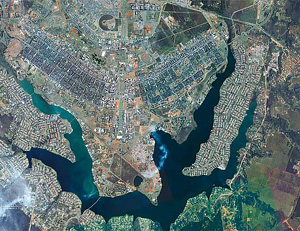
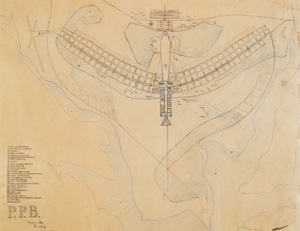
Brasília, aerial view, left; Lúcio Costa, Plano Piloto (Pilot Plan), winning entry to the competition for the masterplan of Brasília, 10 March 1957, courtesy of the Arquivo Público do Distrito Federal, right
It was precisely this modernity of the capital of Claude Debussy's 'century of the aeroplane' that was strongly felt on the day of its 50th anniversary, when our extraordinary dependence on air travel and air transport had been most painfully brought home. It was also this modernity and the spirit of optimism embodied in Brasília's cloudscraping structures that led a Los Angeles journalist last week to observe, rather hypocritically, that they feel 'so distant from our own [attitude]' towards the design of 'brand-new cities...marked more by wariness and anxiety - particularly about looming environmental disaster, terror attacks and global epidemics - than sweeping optimism'.(3) It remains to be seen whether today's apparently forward-looking 'eco-cities' in China and the United Arab Emirates will be proven green or just greenwash. After all, the world's tallest building with a monstrous carbon footprint, Burj Khalifa (Skidmore, Owings and Merril, Dubai, 2010) also claims green features, as did Dongtan in Shanghai, masterplanned by Arup and promised as the world's first eco-city but already denounced for its false environmental claims.(4)
What is however interesting in this criticism of Brazil's federal capital is that attitudes towards it have remained fairly consistent over the last fifty years. Brazil has registered staggering economic growth over the past ten years, combined with significant social achievements, and the world did notice, at least the former. Unlike others, Brazil's boom did not turn out a bubble. The world has come to recognize the efficacy of President Luiz Inácio Lula da Silva's 'financial strategy of the future' that has led to an expanding economy with a parallel reduction of poverty and inequality, as well as the prudence of the Brazilian central bank's financial regulation and monetary policy, which meant that the government did not need to waste billions of dollars to keep the banking system afloat. Yet, Brazil's modernity seems hard to swallow abroad. Stereotypes persist and are often cultivated by the culture and the tourist industries that promote the notion of Brazil as a strangely exotic, primitive land, offering a wealth of images of the Other.
Brazil's new federal capital, located in the country's desolate red earth of the cerrado or tropical savannah of the Brazilian central plateau, is still today habitually discussed as a city in the jungle, still a Eurocentric synonym for Brazil, still perceived as Sigfried Giedion's land 'on the periphery of culture'.(5) According to Manfredo Tafuri and Franceso Dal Co's history of modern architecture of 1976, Brasília 'was sited in the interior of the country, beyond the jungle'.(6) In 1980, Kenneth Frampton wrote that Oscar Niemeyer's 'work at Brasilia...together with Costa's grid, evoked the aura of the genre terrible, the assertion of implacable form against remorseless nature; for beyond the order of Brasilia's Capitol...there lay the infinite extent of the jungle'.(7) In 2005 Frank Gehry remembered: 'We just heard about someplace being hacked out of the middle of some jungle to make a new city.'(8) On its 50th anniversary, on 21 April 2010, Simon Reid-Henry wrote in The Guardian of 'a capital...[that] was hacked out of the jungle by hand' - for obviously in Brazil manual labour was a substitute for technology.(9)
It is important to note here that Brazil itself is not free of Eurocentric attitudes and stereotypes, and has been partly responsible for the dissemination of those images of a city emerging from the tropical jungle. In the late 1950s, government-sponsored publicity material for Brazil's new capital also referred to 'The city in the jungle, urbs ubi silva fuit'.(10) Reporting on the effect of the burgeoning capital on public opinion in Europe, the United States and South America, J.O. de Meira Penna wrote in 1959: 'And for the Europeans it is a double surprise. Just imagine this country which, in their ill informed minds, they till recently thought of as a vast virgin forest, populated by poisonous snakes and naked Indians, this country, that many thought was sunk in the lackadaisical inertia of the tropics, builds a capital city in but three years right in the heart of the jungle, raising delicate concrete structures where the crocodile and the leopard used to roam; this nation hurls its mighty tractors through the densest virgin forest in the world, to carve our gigantic highways'.(11) Even Lúcio Costa made use of the metaphor of the jungle when he said: 'We have to finish Brasília in five years or the jungle will come back'.(12)
In the late 1950s, Brazil was pervaded by a climate of national euphoria and heedless optimism, based on a forward-looking, democratically elected government, vigorously pursuing political stability, innovation and ambitious programmes for rapid economic development, aggressive industrialization and modernization. President Juscelino Kubitschek's audacious transfer of the capital from the coast to the untapped interior marked Brazil's settling of her promised land on the central highlands, as stipulated in the First Republican Constitution of 1891 and reiterated in those of 1934 and 1946. The building of Brasília signified the realization of the old dream of opening up the vast unexplored interior of the country, claiming her legendary natural and material riches, and of unifying the two Brazils, the urban Brazil of the coast, which embodied the European legacy, and the rural one of the hinterland, the truly Brazilian one. Brasília signified a new beginning as well as the culmination of independent Brazil's efforts to become a coherent, integrated and emancipated modern nation, represented by a city built by Brazilians, 1,000 kilometres away from the old centre of colonial power.
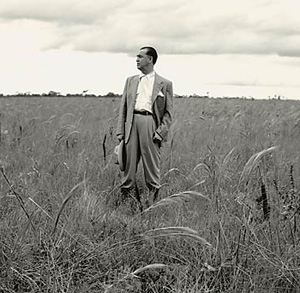
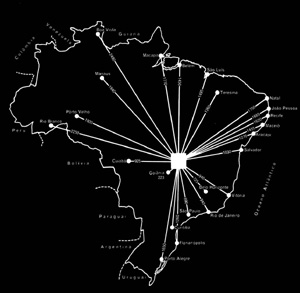
Juscelino Kubitschek on the site of Brasília, 1956, photograph courtesy of the Arquivo Público do Distrito Federal, left; Brasília, frontier capital: map showing the distances between Brasília and other major Brazilian cities, right
In the early 1950s, the Commission for the Localization of the New Federal Capital had undertaken a number of studies for the selection of the site for a new capital city of 500,000 inhabitants. The site had been finally selected on 15 April 1955. Even though Kubitschek's transfer of the capital appears as the logical next step from the actions taken by previous governments with regard to the transfer of the capital, the importance of the political decision to transform the Commission for the Location of the New Federal Capital into a Commission for the Construction of the New Federal Capital should not be underestimated. This decision does not stand alone. It constitutes an essential part of Kubitschek's new, ideologically coherent, political and economic project of a modern, democratic, industrial and urban Brazil. Brasília, conceived as the epicentre of a truly liberated and emancipated, unequivocally modern Brazil, gave a concrete dimension to Kubitschek's 'national developmentalism', which attracted private and foreign investment and stimulated impressive real economic growth (7 per cent from 1957 to 1961), coupled, however, with a soaring budget deficit, a depreciating currency and a galloping inflation rate. Brasília became the 'synthesis goal' or, in Costa's words, the 'keystone' of the arch constructed by Kubitschek, keeping all other stones in place.(13)
On 2 October 1956, Juscelino Kubitschek visited the site of Brasília for the first time, with Oscar Niemeyer, the architect who had agreed to design Brasília's civic monuments, and the war minister, General Henrique Teixeira Lott, and predicted 'a new dawn' for Brazil. On 2 December 1956, construction work started at Brasília's vital point of contact with the rest of the vast country: the airport, which was to have the largest runway in Brazil. The 'first airport in the world specially designed for the age of jets', serving 'the first city planned from the air' was inaugurated on 2 April 1957.(14) Independence Day, 21 April 1960, commemorating the martyrdom in 1792 of Tiradentes, (Lieutenant Joaquim José da Silva Xavier, 1746-92), Brazil's eulogized 'protomartyr of independence', the anniversary of Brazil's discovery and the date of Rome's foundation, was the date set by law for the inauguration of the capital that symbolically marked the completion of the second discovery of Brazil, by the Brazilians themselves. The Herculean task had to be accomplished within Kubitschek's five-year term of office, since, by law, the president could serve only a single term; that is, Brasília had to be completed within three years, one month and five days of the selection of its masterplan.
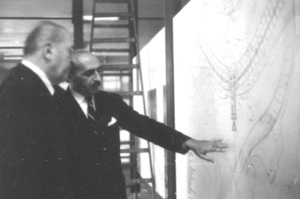
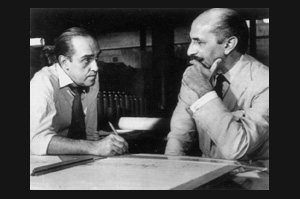
Lúcio Costa showing Brasília's Plano Piloto to Mies van der Rohe, at the office of NOVACAP (Companhia Urbanizadora da Nova Capital do Brasil), in the Ministry of Education and Public Health building in Rio de Janeiro, 1957, photograph by Mario Fontenelle, courtesy of the Arquivo Público do Distrito Federal, left; Oscar Niemeyer and Lúcio Costa discussing the plans for Brasília at the Ministry of Education and Public Health, 1958, photograph courtesy of Arquivo Público do Distrito Federal, right
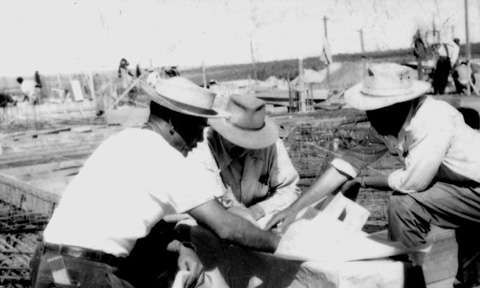
Brasília under construction, in the country's desolate red earth of the cerrado or tropical savannah of the Brazilian central plateau, 1958-60, extract from Tamarski, G., 1960, Brasília (London: The Brazilian Government Trade Bureau), up; construction workers at the Palácio da Alvorada, presidential residence, 1957, photograph courtesy of the Arquivo Público do Distrito Federal, down
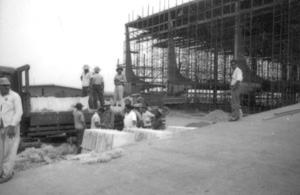
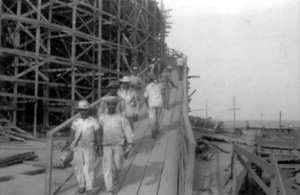
Palácio do Planalto (Presidential Palace), left, and National Congress, right, under construction, 1958-60, photographs courtesy of the Arquivo Público do Distrito Federal
The introduction to the catalogue of the 1943 exhibition Brazil Builds at the Museum of Modern Art in New York had begun with a survey of the country from a 'shining silver airplane'. On the occasion that marked the welcoming of Brazil into the world of modernity, the evocation of the modern device 'rush[ing] over the great river Amazon' had suggested the possibility of taking possession of the impenetrable and unsettled jungle.(15) The Architectural Review of 1944 had predicted that 'if the country becomes air-minded, its development may step up to the speed of the aeroplane'.(16) In the catalogue of the 1955 MoMA exhibition on Latin American Architecture Since 1945, Henry-Russell Hitchcock wrote: 'Today, there is perhaps no part of the world where air traffic is so vital, bringing all the South American countries into close contact with the outside world and, almost more significantly, with each other. Building materials rarely travel by air, but most architects do and their ideas as well. The São Paulo airport is the third busiest in the world, seventy flights a day linking it with Rio de Janeiro alone'.(17) And Aline Saarinen, the New York Times' reviewer of the 1955 exhibition, observed: 'there is in Latin America the excitement of countries suddenly awakened, through arteries of airlines, to communication with the rest of the world and quickly thrust into the modern age'.(18)
The aim of Costa's plan for the 'city of the future' was precisely this: to thrust the whole of Brazil into the modern era represented by the formidable machine, and to bring to the entire nation the modern architecture he had done so much to pioneer over the previous two decades. In 1956, J.O. de Meira Penna wrote: 'it is the "air age" that is fast changing the geopolitical map of the planet. Air transportation has much to do with the convenience and feasibility of building a new capital in the Central Plateau of Brazil. Ours will be the first capital built in the new air age and it is symbolic of the fact that the site was chosen on the basis of aerial surveys'.(19) Costa did not grant the new seat of power an aircraft landing-deck at the centre of the city, like those proposed by Antonio Sant'Elia's Città Nuova (1914) and Le Corbusier's Ville Contemporaine pour trois million habitants (1922).(20) Instead, the plan of Costa's Brazilian civitas of the air age evoked, and symbolically embodied, the modern machine par excellence, thus also celebrating Brazil as the country of the aviation pioneer Mineiro Alberto Santos Dumont. The venerable Futurist device, to which Le Corbusier had dedicated twenty-two pages in his Vers une architecture, came to land at the centre of the country and the nation, thus turning the whole of Brazil into a Ville Contemporaine.(21) Brazil's colonial cities were founded on ports that facilitated control of exports; Costa's aeroplane-shaped, skyway-and-highway-accessed city permitted colonization of the interior and promoted the domestic distribution of Brazil's produce.
Representing a rare historic realization of the Functional City defined by CIAM, significantly, Costa's plan has also given prominence to the airborne view of Brasília, reinforcing its status as a utopian urban order. Costa himself designed the city's Television Tower (1957, constructed 1959-61 and 1965-67), which further promotes Brasília's aerial view, offering it to all its inhabitants and visitors, turning the city intelligible. In this way, Brasília also paid homage to the old capital of Rio de Janeiro which, from its very early days was portrayed from above. In 1840 Rio became the first city in the world to be photographed from the air; in 1885, four years before the Eiffel Tower was completed, Rio had steam trams carrying tourists to the summit of Mount Corcovado to admire the famous bird's-eye view; and its Santos Dumont Airport had been revered for two decades as 'the most beautiful in the world and certainly the most conveniently located...one of the two major buildings that called attention to the development of a brilliant Cariocan [sic] school of modern architecture'.(22)
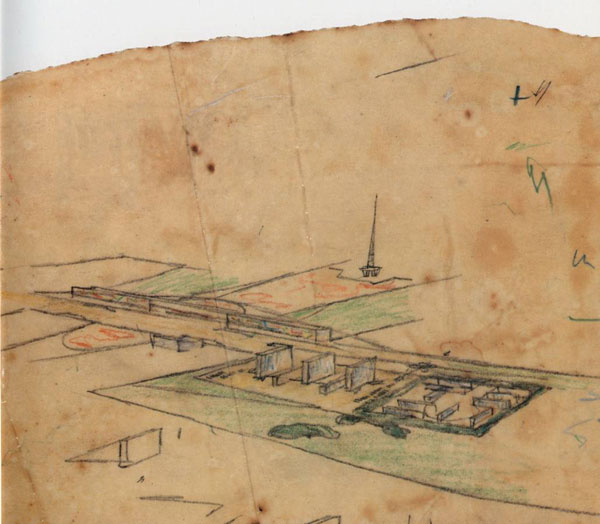
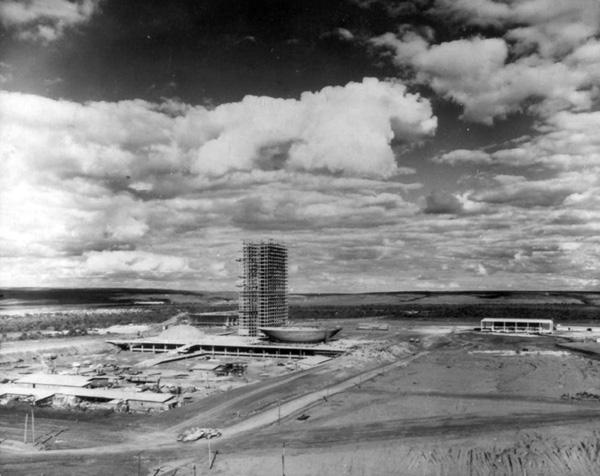
According to Lúcio Costa's 'Report' that accompanied his winning entry for the masterplan of Brasília, 'The tower of the radio and television station...has been integrated as a plastic element in the general composition of the project', 1957, up; view of the triangular Praça dos Três Poderes (Square of the Three Powers) under construction at the eastern tip of Brasília's Monumental Axis, with the National Congress in the foreground and the Presidential Palace and the Supreme Court at the base of the triangle, in the background, 1958-60, down, courtesy of the Arquivo Público do Distrito Federal
Where in Rio, however, it is the wondrous natural landscape that is to be marvelled at, its sinuous bays, hovering hills and forested mountain ranges, inlets, islands and the vast blue Atlantic, overpowering any structure designed by human hand, Brasília's aerial image and landmarks are entirely of human creation. Costa assumed that Brasília's visitors would arrive by aeroplane and ensured that they would be greeted by a clear, rational, two-dimensional image of a planned, unified city, which the flat pictorial surface of the landscape made easier to achieve. With its few, sharp lines, clear geometric shapes, low-lying structures and large-scale open spaces, Brasília was designed to be read from an aerial perspective, not as a city born of nature, 'not as a dynamic habitat, but as a deposit of human intentionality, as a planned text'.(23)
For Le Corbusier, ships, aeroplanes and motor cars epitomised the engineering spirit of the machine age. Like Walter Gropius and other Modernist architects, he regarded the car as 'a challenge to our houses' - the modern machine à habiter - not only for its rigorous expression of function but also for its mass-production. His Maison Citrohan prototype of 1922 was a deliberate pun on Citroën. In the third volume of his Œuvre complète, first published in 1939, he presented 'Ford's works' as exemplary of the 'modern world', opposed to 'barbarism'. Washington Luís, Brazilian president from 1926 to 1930, coined the motto 'to govern is to construct roads', and in 1928 he celebrated the completion of the Rio-São Paulo highway as the major achievement of his administration.(24) Kubitschek's government opened over 17,000 kilometres of new roads and 'highways of national union', some through regions hitherto unmapped, connecting Brasília with the rest of the country, while also making Brazil the world's seventh largest automobile producer (somewhat ironically, an industry concentrated almost entirely in the area of greater São Paulo and in foreign hands).
The automotive emphasis of Costa's plan for a city originally intended to have not one traffic light was consistent with both the new direction of Brazil's industrial development and Le Corbusier's visionary city plans. Already in 1925, the latter had named his plan for the sanitization of Paris after an automobile manufacturer, Gabriel Voisin, one of the two sponsors of the Pavillon de L'Esprit Nouveau for the Exposition des Arts Décoratifs et Industriels Modernes in Paris. And more than a decade before Costa's Plano Piloto, Josep Lluís Sert and Paul Lester Wiener had responded with their Cidade dos Motores (1944, conceived by Atílio Correia Lima in 1943) to a commission for a new, model industrial town of twenty to twenty-five thousand inhabitants, attached to the National Factory of Motors. In his The City of Tomorrow and Its Planning, published in 1925, Le Corbusier showed a picture of Paris and posed the question: 'Is this a picture of the seventh circle of Dante's Inferno?'(25) The Functional City of CIAM promised redemption from all the problems of the chaotic, overpopulated, haphazardly grown, disorderly, uncontrollable cities of the past. Costa's Brasília was conceived as the comprehensive, rational urban order of the machine era.
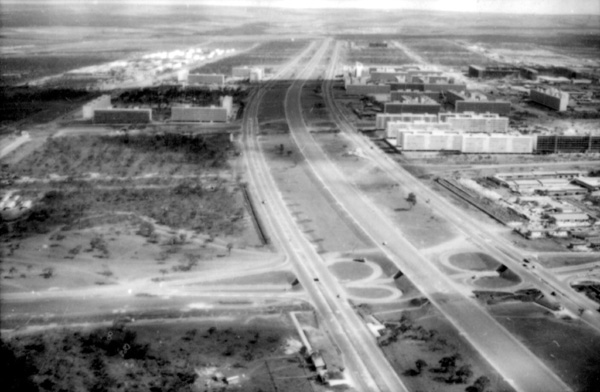
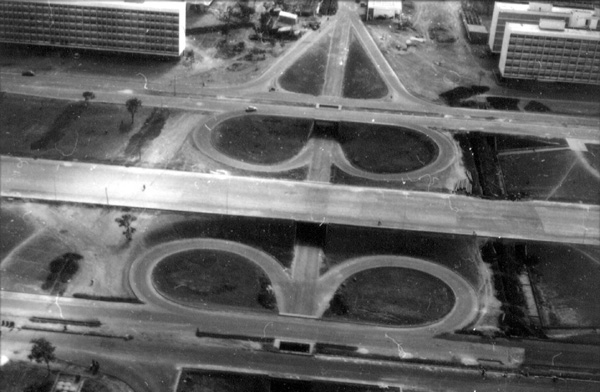
Brasília's Highway-Residential Axis, 1958-60, photographs courtesy of the Arquivo Público do Distrito Federal
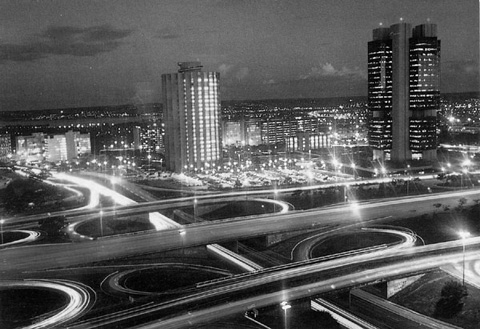
Brasília, 'capital of the highways and skyways': extract from Tamarski, G., 1960, Brasília (London: The Brazilian Government Trade Bureau), up, and photograph courtesy of the Arquivo Público do Distrito Federal, down
The car was regarded by Costa as a 'family member'. Juscelino Kubitcheck demanded that every car manufacturer must offer an affordable basic version within their range, a car that as many Brazilians as possible could afford. While this was welcome news for Volkswagen, for example, Simca do Brasil was not exactly pleased with the idea as the brand had established itself comfortably in the luxury car sector in a way that Simca back in Europe never managed. However, despite having no plans to launch a cheap car and with no other options left, Simca do Brasil decided reluctantly to create an entry level version of their successful Simca Chambord. The Simca Alvorada appeared in 1963 with just two colours as option (grey and a faded yellow), no chrome, no trimmings and a very simple interior. As a silent protest the car was named after the place the order to create this model came from: the Palácio da Alvorada, the official presidential residence in Brazil's new capital.
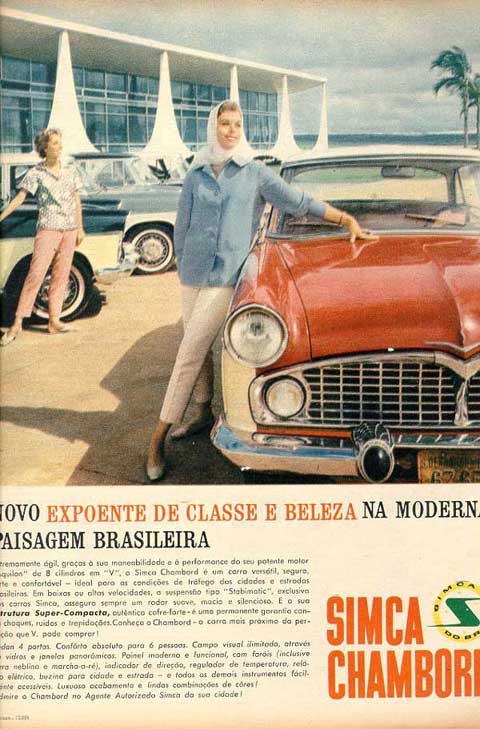
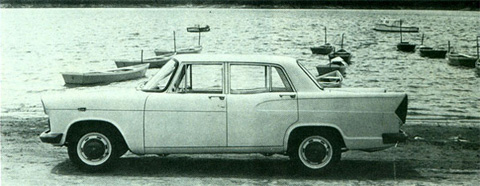
Advertisement for Simca Chambord showing the cars in front of the Palácio da Alvorada, up; Simca Alvorada, down
For Brasília's 'distinguished visitors' Costa had foreseen two different itineraries: one to be followed upon arrival and a second one for their departure. The first one was to be a journey along 'an independent highway which directly connects the airport and the civic center', showcasing Brasília as the modern capital of speed and efficiency. The second one was to 'be made by the residential highway itself which displays the city to advantage'.(26) Costa had thus arranged for the visitor to leave Brasília with an image of 'Beauty' where 'mathematical exactness is joined to daring and imagination'.(27)
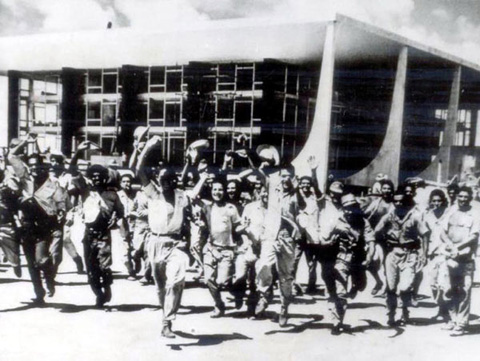
Candangos, Brasília's construction workers, in front of the Supreme Court, Praça dos Três Poderes, 1959-60, photograph courtesy of the Arquivo Público do Distrito Federal, up; Brasília, 21 April 1960, inauguration day, extract from Tamarski, G., 1960, Brasília (London: The Brazilian Government Trade Bureau), down
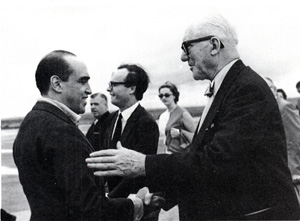
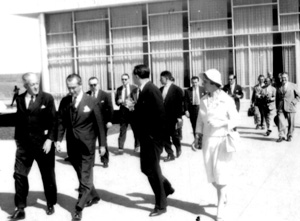
Le Corbusier congratulating Oscar Niemeyer, Brasília, 1962 (between the two men is the architect Ítalo Campofiorito), left; Israël Pinheiro (the man who oversaw the construction of Brasília as second president of NOVACAP, and Brasília's first mayor), President Juscelino Kubitschek and French Minister André Malraux at the Palácio da Alvorada, August 1959, right, photographs courtesy of the Arquivo Público do Distrito Federal
Notes
1 For an analytical study of Brasília and its architecture, see Philippou, Styliane, 2008, Oscar Niemeyer: Curves of Irreverence (New Haven and London: Yale University Press), pp. 211-313.
See also: Vidal, Laurent, 2002, De Nova Lisboa à Brasília: l'invention d'une capitale (XIXe-XXe siècles) (Paris: IHEAL, Institut des hautes études de l'Amérique latine).
2 Costa, Lúcio, 1966, 'Report by Lúcio Costa'. In Willy Stäubli, Brasilia (Stuttgart: Alexander Koch), p. 16.
3 Hawthorne, Christopher, 2010, 'Brasilia's Embrace of the Future Seems so Quaint', Los Angeles Times, 21 April, http://www.latimes.com/entertainment/news/la-et-brasilia-20100421,0,7319435.story
4 See Pearce, Fred, 2009, 'Greenwash: The dream of the first eco-city was built on a fiction', The Guardian, 23 April, http://www.guardian.co.uk/environment/2009/apr/23/greenwash-dongtan-ecocity
5 Giedion, Sigfried, 1982, 'Brasilien und die heutige Architektur' (1953). In Oscar Niemeyer: Selbstdarstellung, Kritiken, Oeuvre, ed. Alexander Fils (Münsterschwarzach: Benedict Press, Frölich & Kaufmann), p. 94.
6 Tafuri, Manfredo, and Francesco Dal Co, 1976, Modern Architecture (Milan: Electa, London: Faber and Faber), vol. 2, p. 354.
7 Frampton, Kenneth, 1992, Modern Architecture: A Critical History, 3rd ed. revised and enlarged (London: Thames and Hudson), p. 256.
8 Quoted in Kimmelman, Michael, 2005, 'The Last of the Moderns', New York Times, 15 May, http:// www.nytimes.com/2005/05/15/magazine/15NIEMEYER.html?pagewanted=1&ei=5088&en=a3ec479
9 Reid-Henry, Simon, 2010, 'Bold Brasilia at 50', The Guardian, 21 April, http://www.guardian.co.uk/commentisfree/2010/apr/21/brasilia-50th-anniversary
10 Penna, J.O. de Meira, n.d. 'Brazil Builds a New Capital'. In Brasília (Rio de Janeiro: Divisão Cultural, Ministério das Relações Exteriores), n.p. (Originally in Landscape 5, no. 21 (Spring 1956), pp. 17-22).
11 J.O. de Meira Penna, quoted in Evenson, Norma, 1973, 1973, Two Brazilian Capitals: Architecture and Urbanism in Rio de Janeiro and Brasília (New Haven and London: Yale University Press), p. 162.
12 Quoted in Evenson, Norma, 1975, 'Brasilia: "Yesterday's City of Tomorrow"'. In World Capitals: Toward Guided Urbanization, ed. H. Wentworth Eldredge (Garden City, New York: Doubleday & Co), p. 485.
13 Juscelino Kubitschek; Lúcio Costa, quoted in Shoumatoff, Alex, 1990, The Capital of Hope: Brasília and Its People (New York: Vintage Books), p. 38.
14 Israël Pinheiro, the man who oversaw the construction of Brasília as second president of NOVACAP (and Brasília's first mayor), quoted in Dos Passos, John, 1963, Brazil on the Move (Garden City, New York: Doubleday & Co), p. 76.
15 Goodwin, Philip L., 1943, Brazil Builds: Architecture New and Old 1652-1942 (New York: Museum of Modern Art, exhibition catalogue, bilingual edition), p. 17.
16 Sousa-Leão, J. de, 1944, 'Brazil: The Background', Architectural Review 95, no. 567 (March), special issue on Brazil, p. 59.
17 Hitchcock, Henry-Russell, 1955, Latin American Architecture Since 1945 (New York: Museum of Modern Art, exhibition catalogue), p. 12.
18 Quoted in Real, Patricio del, 2007, 'Building a Continent: MOMA's Latin American Architecture Since 1945 Exhibition', Journal of Latin American Cultural Studies 16, no. 1 (March), p. 105.
19 But he also noted: 'Goiania might in a sense be considered the first city of the air age, a city carved out of the jungle around an airport. Its very site was selected by aerial inspection and photoanalysis. And although it is now linked with Minas Gerais by railway and an all-weather road, its main connection with the outside world is still by air.' Penna, n.d., n.p.
20 The airport was also monumentally positioned on a river island in Le Corbusier's 1929 sketch for Buenos Aires; Le Corbusier, 1991, Precisions: On the Present State of Architecture and City Planning (Cambridge, Massachusetts, and London: MIT Press), p. 202.
21 Le Corbusier, 1989, Towards a New Architecture, trans. Frederick Etchells (London: Butterworth Architecture [1923 in French]), pp. 105-27. It seems likely that Le Corbusier flew in an aeroplane for the first time during his first Latin American visit in 1929.
22 Hitchcock, p. 12.
23 Saint-Amour, Paul K., 2003, 'Modernist Reconnaissance', Modernism/Modernity 10, no. 2 (April), p. 352.
24 Garcia, Eugenio Vargas, 2000, 'Anglo-American Rivalry in Brazil: The Case of the 1920s', working paper series CBS-14-2000 (Oxford: Centre for Brazilian Studies, University of Oxford), http://www.brazil.ox.ac.uk/workingpapers/Eugenio14A.pdf, p. 11.
25 Le Corbusier, 1987, The City of Tomorrow and Its Planning (New York: Dover [1925 in French as Urbanisme, 1929 in English]), p. 284.
26 Costa, 1966, p. 16.
27 Le Corbusier, 1989, p. 18.
Related articles:
- 360 Degrees Architecture ( 10 October, 2009 )
- Τhe Roots of the Industry of the Image ( 27 October, 2009 )
- Anish Kapoor: Non-objective Objects ( 26 November, 2009 )
- Love Thy Planet ( 28 December, 2009 )
- Europe’s Civilization under Threat ( 28 January, 2010 )
- Made of Stone and Water, for the Human Body ( 28 February, 2010 )
- Bokja: ‘A Woman’s Affair’ ( 28 March, 2010 )
- Brasília from the Beginning, Fifty Years Ago ( 07 April, 2010 )
- Oscar Niemeyer’s Permanent International Fair in Tripoli ( 29 May, 2010 )
- Learning from Miami ( 10 July, 2010 )
- The Greatest Show on the Beach ( 08 August, 2010 )
- Oscar Niemeyer: Curves of Irreverence ( 28 March, 2011 )
- The Lizards of Djenné ( 26 September, 2010 )
- Transformed by Couture ( 29 October, 2010 )
- Another Athens Is Possible ( 02 December, 2010 )
- From Juan O’Gorman for Diego Rivera and Frida Kahlo ( 28 February, 2011 )
- Roberto Burle Marx: The Marvellous Art of Landscape Design ( 27 May, 2011 )
- The Danger that Lurks on this Side of the Gates ( 10 September, 2011 )
- Eduardo Souto de Moura ( 21 November, 2011 )










